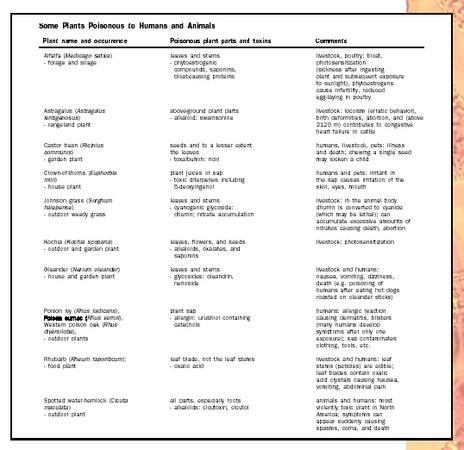Poisonous Plants
Poisonous plants contain substances that can cause sickness or death if those substances are ingested or come into contact with the body of an animal. These substances are often referred to as "secondary compounds." Primary

| Some Plants Poisonous to Humans and Animals | ||
| Plant name and occurrence | Poisonous plant parts and toxins | Comments |
|
Alfalfa (
Medicago sativa
)
- forage and silage |
leaves and stems
- phytoestrogenic compounds, saponins, bloat-causing proteins |
livestock, poultry: bloat, photosensitization (sickness after ingesting plant and subsequent exposure to sunlight), phytoestrogens cause infertility, reduced egg-laying in poultry |
|
Astragalus (
Astragalus lentigenosus
)
- rangeland plant |
above-ground plant parts
- alkaloid: swainsonine |
livestock: locoism (erratic behavior), birth deformities, abortion, and (above 2120 m) contributes to congestive heart failure in cattle |
|
Castor bean (
Ricinius communis
)
- garden plant |
seeds and to a lesser extent the leaves
- toxalbumin: ricin |
humans, livestock, pets: illness and death; chewing a single seed may sicken a child |
|
Crown-of-thorns (
Euphorbia milii
)
- house plant |
plant juices or sap
- toxic diterpenes including 5-deoxyingenol |
humans and pets: irritant in the sap causes irritation of the skin, eyes, mouth |
|
Johnson grass (
Sorghum halepense
)
- outdoor weedy grass |
leaves and stems
- cyanogenic glycoside: dhurrin; nitrate accumulation |
livestock: in the animal body dhurrin is converted to cyanide (which may be lethal); can accumulate excessive amounts of nitrates causing death, abortion |
|
Kochia (
Kochia scoparia
)
- outdoor and garden plant |
leaves, flowers, and seeds
- alkaloids, oxalates, and saponins |
livestock: photosensitization |
|
Oleander (
Nerium oleander
)
- house and garden plant |
leaves and stems
- glycosides: oleandrin, nerioside |
livestock and humans: nausea, vomiting, dizziness, death (e.g. poisoning of humans after eating hot dogs roasted on oleander sticks) |
|
Poison ivy (
Rhus radicans
),
Poison sumac
(
Rhus vernix
), Western poison oak (
Rhus diversiloba
),
- outdoor plants |
plant sap
- allergin: urushiol containing catechols |
humans: allergic reaction causing dermatitis, blisters (many humans develop symptoms after only one exposure); sap contaminates clothing, tools, etc. |
|
Rhubarb (
Rheum raponticum
):
- food plant |
leaf blade, not the leaf stems
- oxalic acid |
livestock and humans: leaf stems (petioles) are edible; leaf blades contain oxalic acid crystals causing nausea, vomiting, abdominal pain |
|
Spotted water-hemlock (
Cicuta maculata
)
- outdoor plant |
all parts, especially roots
- alkaloids: cicutoxin, cicutol |
animals and humans: most violently toxic plant in North America; symptoms can appear suddenly causing spasms, coma, and death |
compounds are chemicals involved in basic metabolism , whereas secondary compounds are chemicals that are generally waste products of metabolism. Secondary plant compounds, the toxic substances, have coevolved in higher plants in response to attack by herbivorous insects for over one hundred million years. Animals are poisoned when the animals' protection mechanisms (detoxification) are inadequate.
Secondary compounds include chemicals such as alkaloids, glycosides, oxalates, saponins, tannins, and toxalbumins. These chemicals are toxic in various ways to vertebrates. Some responses are dramatic (violent spasms, death) or subtle (reduced weight gain, birth defects). Other chemicals are only toxic after being altered inside the animal body (for example, cyanogenic glycosides, which produce cyanide) or if the animal is exposed to the sun (photosensitization). Researchers continue to discover new toxins from plants.
In 1986 it was estimated that poisoning of cattle, sheep, and horses grazing western U.S. rangelands cost ranchers $190 million per year. Most cases of human poisoning involve house and garden plants. In 1998 there were 122,578 plant-related calls to poison control centers in the United States, according to information from the American Association of Poison Control Centers. Only 109 of those cases were serious (but included four fatalities).
Some cases of plant poisoning are remarkable. During the nineteenth century tragic loss of human life occurred from a mysterious milk sickness in which cattle ingested white snakeroot and a toxin was passed on to humans through the milk. In 1971 near Garrison, Utah, more than twelve hundred sheep died after ingesting the rangeland plant halogeton. Although these toxic compounds are harmful to most species that ingest them, some insects are not harmed by some of the toxins and actually sequester the poison in their own body as a defense against their own predators.
Derek Bishop Munro
Bibliography
Keeler, Richard F., Kent R. Van Kampen, and Lynn F. James, eds. Effects of Poisonous Plants on Livestock. New York: Academic Press, 1978.
Munro, Derek B. Canadian Poisonous Plants Information System. <http://sis.agr.gc.ca/poison/> . Agriculture and Agri-Food Canada, 1993.
Spoerke, David G., and Susan C. Smolinske. Toxicity of Houseplants. Boca Raton, FL: CRC Press, 1990.
When white snakeroot is eaten by livestock, it can cause a sickness known as trembles. Symptoms in animals include depression, inactivity, labored breathing, loss of weight, and trembling.
I have been feeding lucerne (alfalfa) to my poultry for 10 years without any " livestock, poultry: bloat, photosensitization (sickness after ingesting plant and subsequent exposure to sunlight), phytoestrogens cause infertility, reduced egg-laying in poultry" problems. I have also eaten sprouted alfalfa without any side affects.